BSc Business Management: Knowledge and Information Systems Report
VerifiedAdded on 2023/01/16
|11
|2599
|66
Report
AI Summary
This report delves into the significance of knowledge management in achieving organizational long-term objectives. It explores the strategic importance of knowledge management in enhancing competitive positions, fostering technology leadership, improving employee relations and productivity, boosting profitability, ensuring return on investments, and building a strong corporate image. The report further evaluates the impact of Radio Frequency Identification (RFID) on business process efficiency, highlighting its role in streamlining operations and improving data accuracy. A detailed discussion on the process of RFID tracking inventory movements within the retail sector is also provided, emphasizing its contribution to enhancing management information quality, improving time management, and reducing costs associated with inventory control. The report concludes by summarizing the key findings and emphasizing the benefits of implementing knowledge management and RFID technologies for overall business success.
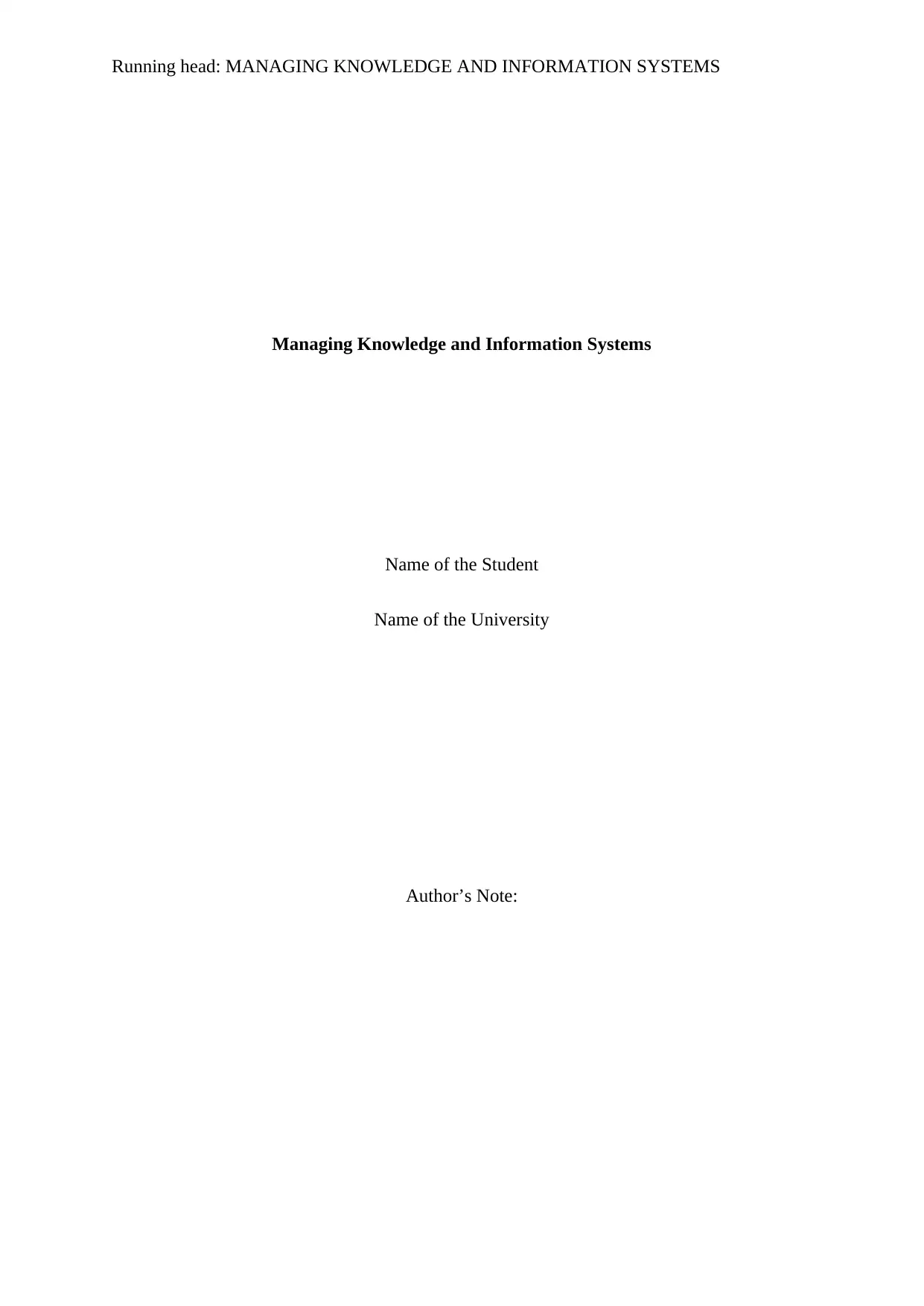
Running head: MANAGING KNOWLEDGE AND INFORMATION SYSTEMS
Managing Knowledge and Information Systems
Name of the Student
Name of the University
Author’s Note:
Managing Knowledge and Information Systems
Name of the Student
Name of the University
Author’s Note:
Paraphrase This Document
Need a fresh take? Get an instant paraphrase of this document with our AI Paraphraser

1
MANAGING KNOWLEDGE AND INFORMATION SYSTEMS
Table of Contents
1. Introduction............................................................................................................................2
2. Discussion..............................................................................................................................2
2.1 Discussion of Strategic Importance of Knowledge Management for helping
Organizations to Obtain Long Term Objectives....................................................................2
2.2 Evaluation of Impact of RFID on Business Process Efficiency......................................4
2.3 Discussion of Process of RFID tracking Inventory Movements to Improvise
Management Information Quality in Retail Sector................................................................6
3. Conclusion..............................................................................................................................7
References..................................................................................................................................9
MANAGING KNOWLEDGE AND INFORMATION SYSTEMS
Table of Contents
1. Introduction............................................................................................................................2
2. Discussion..............................................................................................................................2
2.1 Discussion of Strategic Importance of Knowledge Management for helping
Organizations to Obtain Long Term Objectives....................................................................2
2.2 Evaluation of Impact of RFID on Business Process Efficiency......................................4
2.3 Discussion of Process of RFID tracking Inventory Movements to Improvise
Management Information Quality in Retail Sector................................................................6
3. Conclusion..............................................................................................................................7
References..................................................................................................................................9
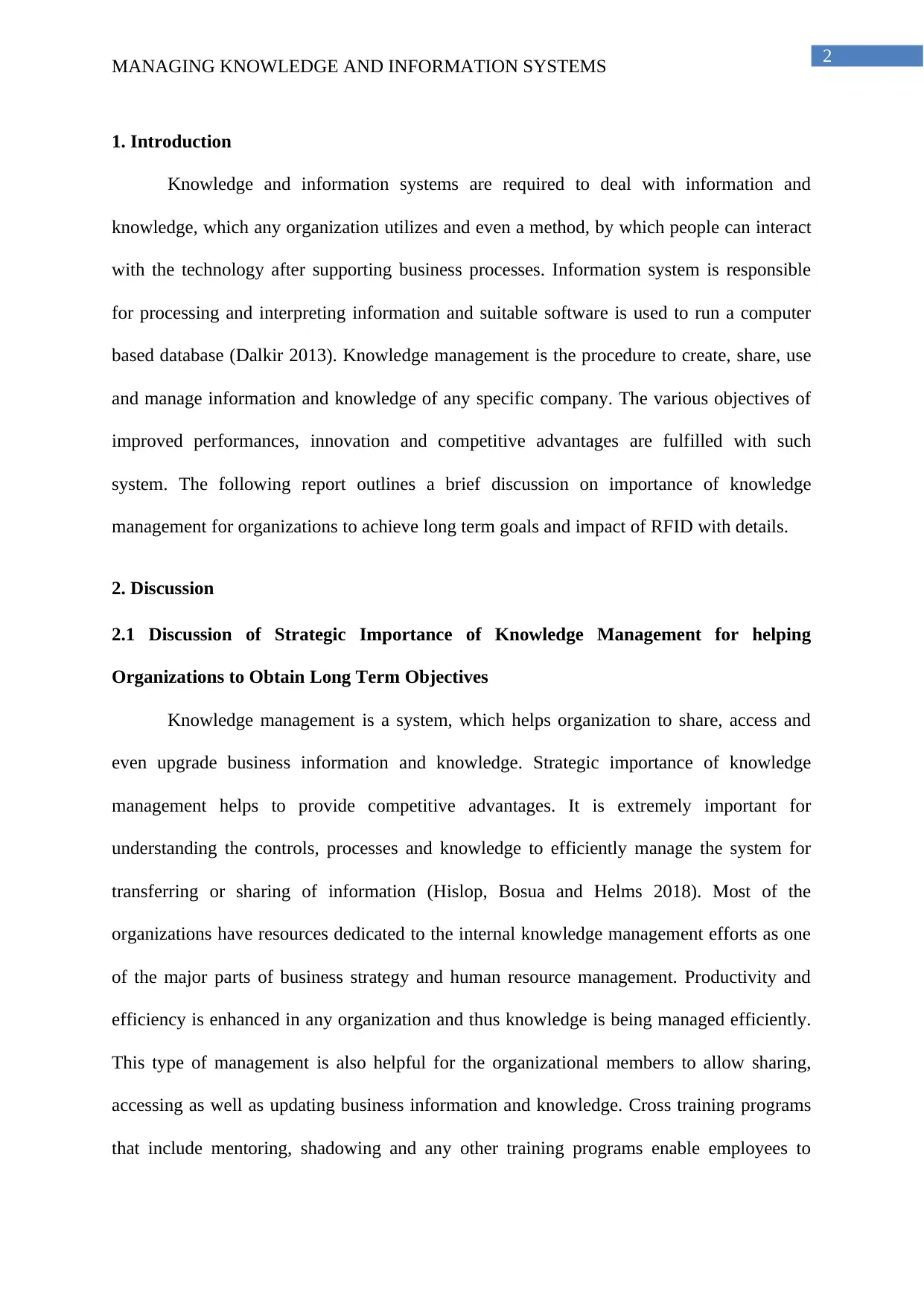
2
MANAGING KNOWLEDGE AND INFORMATION SYSTEMS
1. Introduction
Knowledge and information systems are required to deal with information and
knowledge, which any organization utilizes and even a method, by which people can interact
with the technology after supporting business processes. Information system is responsible
for processing and interpreting information and suitable software is used to run a computer
based database (Dalkir 2013). Knowledge management is the procedure to create, share, use
and manage information and knowledge of any specific company. The various objectives of
improved performances, innovation and competitive advantages are fulfilled with such
system. The following report outlines a brief discussion on importance of knowledge
management for organizations to achieve long term goals and impact of RFID with details.
2. Discussion
2.1 Discussion of Strategic Importance of Knowledge Management for helping
Organizations to Obtain Long Term Objectives
Knowledge management is a system, which helps organization to share, access and
even upgrade business information and knowledge. Strategic importance of knowledge
management helps to provide competitive advantages. It is extremely important for
understanding the controls, processes and knowledge to efficiently manage the system for
transferring or sharing of information (Hislop, Bosua and Helms 2018). Most of the
organizations have resources dedicated to the internal knowledge management efforts as one
of the major parts of business strategy and human resource management. Productivity and
efficiency is enhanced in any organization and thus knowledge is being managed efficiently.
This type of management is also helpful for the organizational members to allow sharing,
accessing as well as updating business information and knowledge. Cross training programs
that include mentoring, shadowing and any other training programs enable employees to
MANAGING KNOWLEDGE AND INFORMATION SYSTEMS
1. Introduction
Knowledge and information systems are required to deal with information and
knowledge, which any organization utilizes and even a method, by which people can interact
with the technology after supporting business processes. Information system is responsible
for processing and interpreting information and suitable software is used to run a computer
based database (Dalkir 2013). Knowledge management is the procedure to create, share, use
and manage information and knowledge of any specific company. The various objectives of
improved performances, innovation and competitive advantages are fulfilled with such
system. The following report outlines a brief discussion on importance of knowledge
management for organizations to achieve long term goals and impact of RFID with details.
2. Discussion
2.1 Discussion of Strategic Importance of Knowledge Management for helping
Organizations to Obtain Long Term Objectives
Knowledge management is a system, which helps organization to share, access and
even upgrade business information and knowledge. Strategic importance of knowledge
management helps to provide competitive advantages. It is extremely important for
understanding the controls, processes and knowledge to efficiently manage the system for
transferring or sharing of information (Hislop, Bosua and Helms 2018). Most of the
organizations have resources dedicated to the internal knowledge management efforts as one
of the major parts of business strategy and human resource management. Productivity and
efficiency is enhanced in any organization and thus knowledge is being managed efficiently.
This type of management is also helpful for the organizational members to allow sharing,
accessing as well as updating business information and knowledge. Cross training programs
that include mentoring, shadowing and any other training programs enable employees to
⊘ This is a preview!⊘
Do you want full access?
Subscribe today to unlock all pages.

Trusted by 1+ million students worldwide
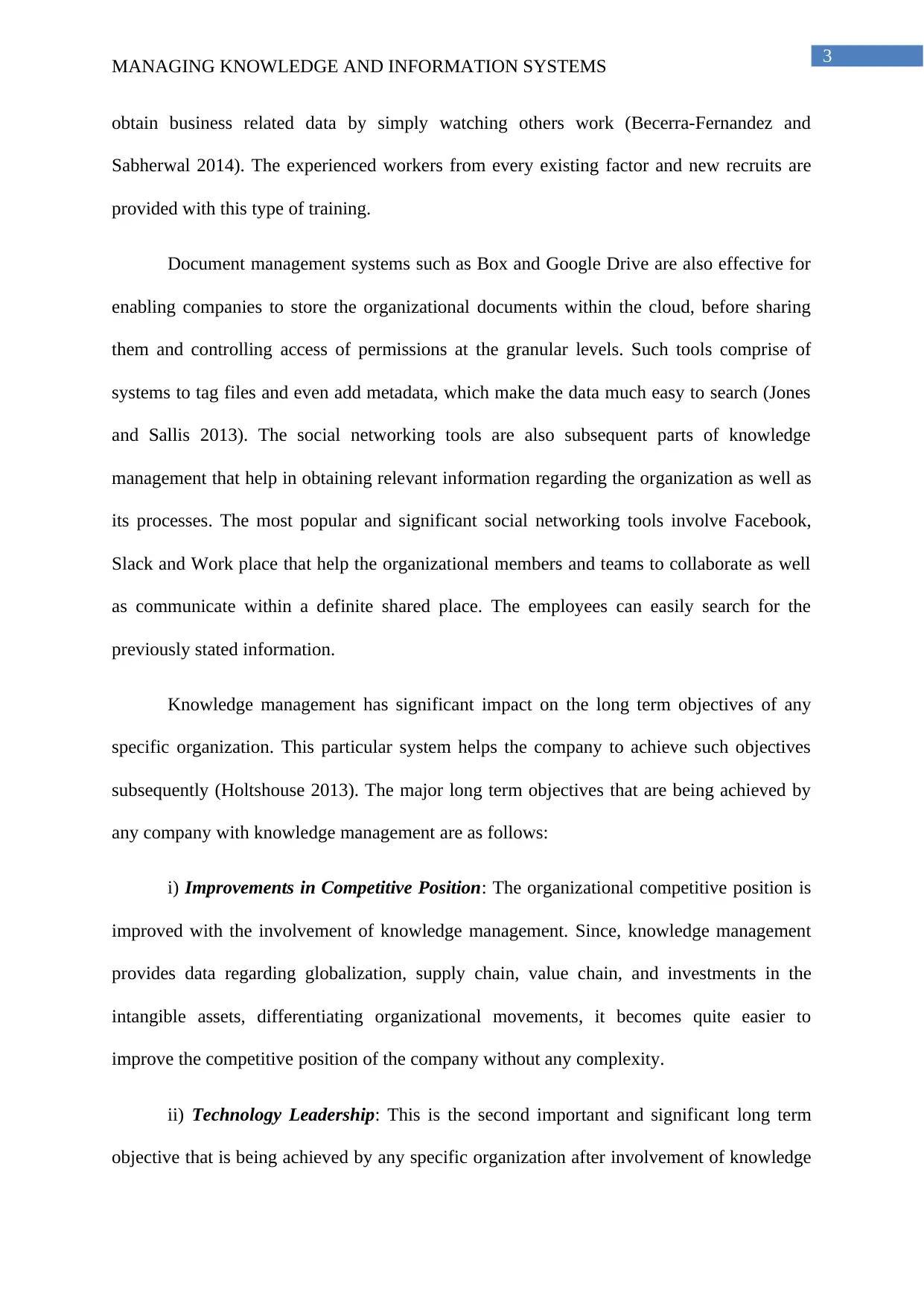
3
MANAGING KNOWLEDGE AND INFORMATION SYSTEMS
obtain business related data by simply watching others work (Becerra-Fernandez and
Sabherwal 2014). The experienced workers from every existing factor and new recruits are
provided with this type of training.
Document management systems such as Box and Google Drive are also effective for
enabling companies to store the organizational documents within the cloud, before sharing
them and controlling access of permissions at the granular levels. Such tools comprise of
systems to tag files and even add metadata, which make the data much easy to search (Jones
and Sallis 2013). The social networking tools are also subsequent parts of knowledge
management that help in obtaining relevant information regarding the organization as well as
its processes. The most popular and significant social networking tools involve Facebook,
Slack and Work place that help the organizational members and teams to collaborate as well
as communicate within a definite shared place. The employees can easily search for the
previously stated information.
Knowledge management has significant impact on the long term objectives of any
specific organization. This particular system helps the company to achieve such objectives
subsequently (Holtshouse 2013). The major long term objectives that are being achieved by
any company with knowledge management are as follows:
i) Improvements in Competitive Position: The organizational competitive position is
improved with the involvement of knowledge management. Since, knowledge management
provides data regarding globalization, supply chain, value chain, and investments in the
intangible assets, differentiating organizational movements, it becomes quite easier to
improve the competitive position of the company without any complexity.
ii) Technology Leadership: This is the second important and significant long term
objective that is being achieved by any specific organization after involvement of knowledge
MANAGING KNOWLEDGE AND INFORMATION SYSTEMS
obtain business related data by simply watching others work (Becerra-Fernandez and
Sabherwal 2014). The experienced workers from every existing factor and new recruits are
provided with this type of training.
Document management systems such as Box and Google Drive are also effective for
enabling companies to store the organizational documents within the cloud, before sharing
them and controlling access of permissions at the granular levels. Such tools comprise of
systems to tag files and even add metadata, which make the data much easy to search (Jones
and Sallis 2013). The social networking tools are also subsequent parts of knowledge
management that help in obtaining relevant information regarding the organization as well as
its processes. The most popular and significant social networking tools involve Facebook,
Slack and Work place that help the organizational members and teams to collaborate as well
as communicate within a definite shared place. The employees can easily search for the
previously stated information.
Knowledge management has significant impact on the long term objectives of any
specific organization. This particular system helps the company to achieve such objectives
subsequently (Holtshouse 2013). The major long term objectives that are being achieved by
any company with knowledge management are as follows:
i) Improvements in Competitive Position: The organizational competitive position is
improved with the involvement of knowledge management. Since, knowledge management
provides data regarding globalization, supply chain, value chain, and investments in the
intangible assets, differentiating organizational movements, it becomes quite easier to
improve the competitive position of the company without any complexity.
ii) Technology Leadership: This is the second important and significant long term
objective that is being achieved by any specific organization after involvement of knowledge
Paraphrase This Document
Need a fresh take? Get an instant paraphrase of this document with our AI Paraphraser
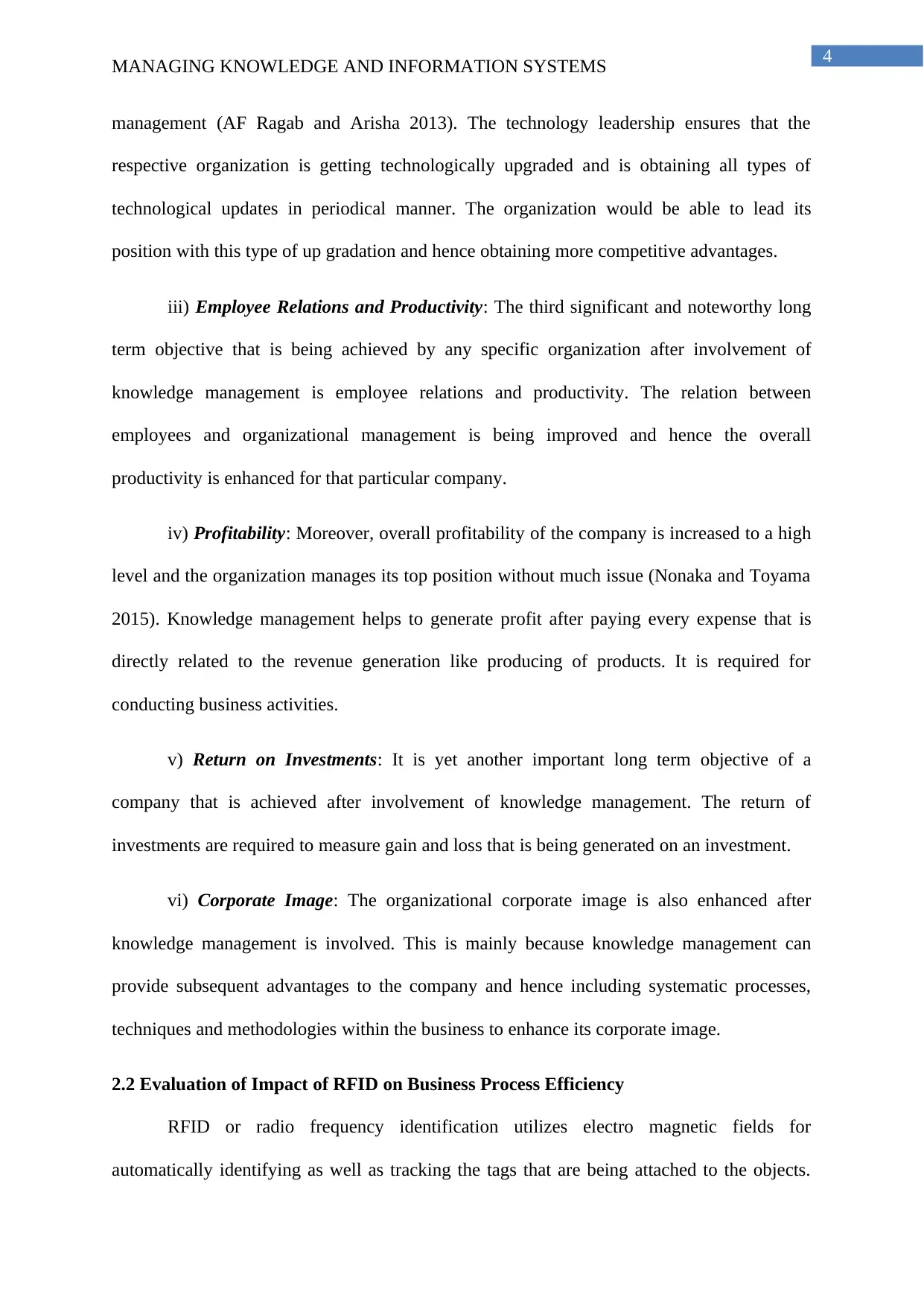
4
MANAGING KNOWLEDGE AND INFORMATION SYSTEMS
management (AF Ragab and Arisha 2013). The technology leadership ensures that the
respective organization is getting technologically upgraded and is obtaining all types of
technological updates in periodical manner. The organization would be able to lead its
position with this type of up gradation and hence obtaining more competitive advantages.
iii) Employee Relations and Productivity: The third significant and noteworthy long
term objective that is being achieved by any specific organization after involvement of
knowledge management is employee relations and productivity. The relation between
employees and organizational management is being improved and hence the overall
productivity is enhanced for that particular company.
iv) Profitability: Moreover, overall profitability of the company is increased to a high
level and the organization manages its top position without much issue (Nonaka and Toyama
2015). Knowledge management helps to generate profit after paying every expense that is
directly related to the revenue generation like producing of products. It is required for
conducting business activities.
v) Return on Investments: It is yet another important long term objective of a
company that is achieved after involvement of knowledge management. The return of
investments are required to measure gain and loss that is being generated on an investment.
vi) Corporate Image: The organizational corporate image is also enhanced after
knowledge management is involved. This is mainly because knowledge management can
provide subsequent advantages to the company and hence including systematic processes,
techniques and methodologies within the business to enhance its corporate image.
2.2 Evaluation of Impact of RFID on Business Process Efficiency
RFID or radio frequency identification utilizes electro magnetic fields for
automatically identifying as well as tracking the tags that are being attached to the objects.
MANAGING KNOWLEDGE AND INFORMATION SYSTEMS
management (AF Ragab and Arisha 2013). The technology leadership ensures that the
respective organization is getting technologically upgraded and is obtaining all types of
technological updates in periodical manner. The organization would be able to lead its
position with this type of up gradation and hence obtaining more competitive advantages.
iii) Employee Relations and Productivity: The third significant and noteworthy long
term objective that is being achieved by any specific organization after involvement of
knowledge management is employee relations and productivity. The relation between
employees and organizational management is being improved and hence the overall
productivity is enhanced for that particular company.
iv) Profitability: Moreover, overall profitability of the company is increased to a high
level and the organization manages its top position without much issue (Nonaka and Toyama
2015). Knowledge management helps to generate profit after paying every expense that is
directly related to the revenue generation like producing of products. It is required for
conducting business activities.
v) Return on Investments: It is yet another important long term objective of a
company that is achieved after involvement of knowledge management. The return of
investments are required to measure gain and loss that is being generated on an investment.
vi) Corporate Image: The organizational corporate image is also enhanced after
knowledge management is involved. This is mainly because knowledge management can
provide subsequent advantages to the company and hence including systematic processes,
techniques and methodologies within the business to enhance its corporate image.
2.2 Evaluation of Impact of RFID on Business Process Efficiency
RFID or radio frequency identification utilizes electro magnetic fields for
automatically identifying as well as tracking the tags that are being attached to the objects.
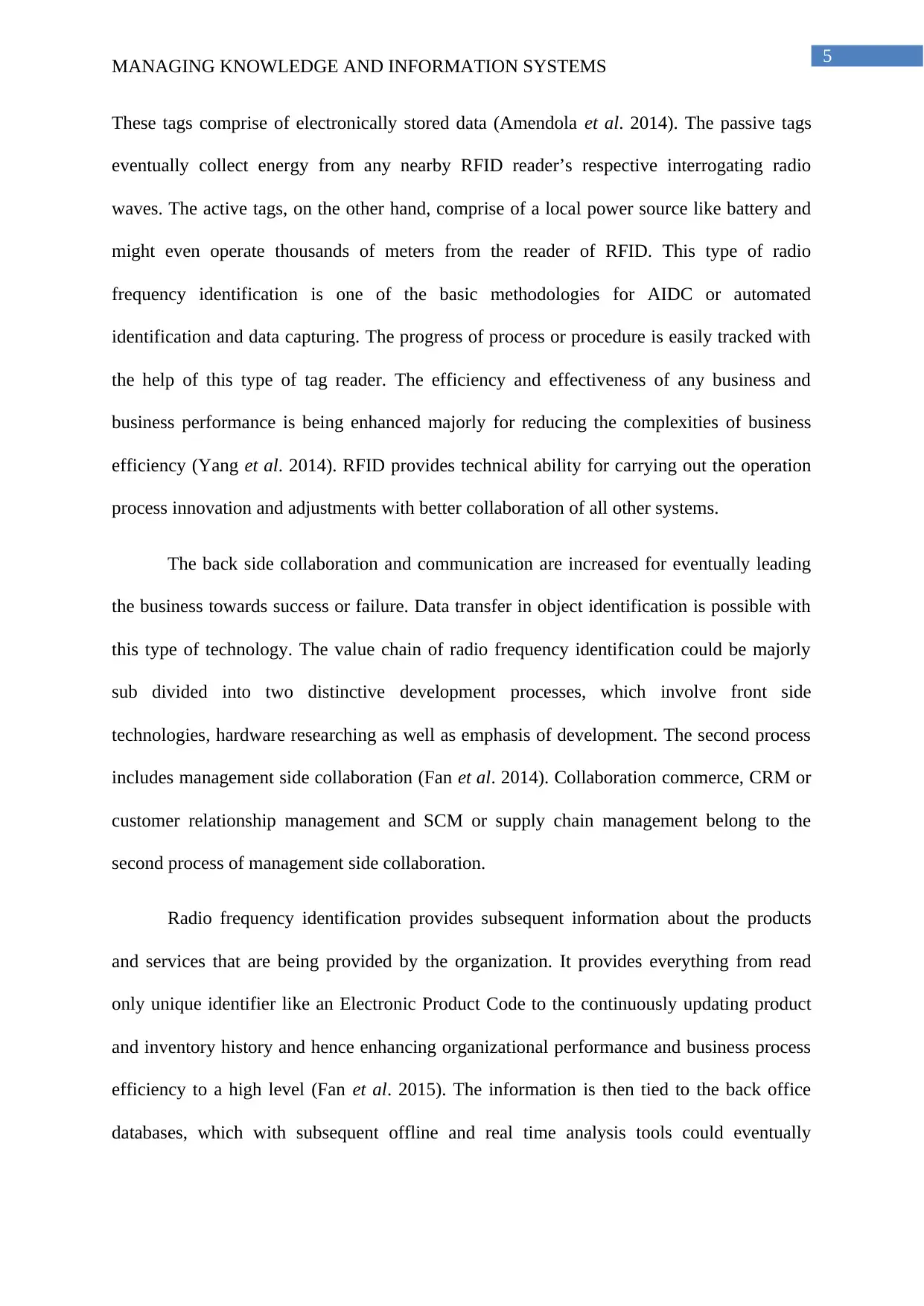
5
MANAGING KNOWLEDGE AND INFORMATION SYSTEMS
These tags comprise of electronically stored data (Amendola et al. 2014). The passive tags
eventually collect energy from any nearby RFID reader’s respective interrogating radio
waves. The active tags, on the other hand, comprise of a local power source like battery and
might even operate thousands of meters from the reader of RFID. This type of radio
frequency identification is one of the basic methodologies for AIDC or automated
identification and data capturing. The progress of process or procedure is easily tracked with
the help of this type of tag reader. The efficiency and effectiveness of any business and
business performance is being enhanced majorly for reducing the complexities of business
efficiency (Yang et al. 2014). RFID provides technical ability for carrying out the operation
process innovation and adjustments with better collaboration of all other systems.
The back side collaboration and communication are increased for eventually leading
the business towards success or failure. Data transfer in object identification is possible with
this type of technology. The value chain of radio frequency identification could be majorly
sub divided into two distinctive development processes, which involve front side
technologies, hardware researching as well as emphasis of development. The second process
includes management side collaboration (Fan et al. 2014). Collaboration commerce, CRM or
customer relationship management and SCM or supply chain management belong to the
second process of management side collaboration.
Radio frequency identification provides subsequent information about the products
and services that are being provided by the organization. It provides everything from read
only unique identifier like an Electronic Product Code to the continuously updating product
and inventory history and hence enhancing organizational performance and business process
efficiency to a high level (Fan et al. 2015). The information is then tied to the back office
databases, which with subsequent offline and real time analysis tools could eventually
MANAGING KNOWLEDGE AND INFORMATION SYSTEMS
These tags comprise of electronically stored data (Amendola et al. 2014). The passive tags
eventually collect energy from any nearby RFID reader’s respective interrogating radio
waves. The active tags, on the other hand, comprise of a local power source like battery and
might even operate thousands of meters from the reader of RFID. This type of radio
frequency identification is one of the basic methodologies for AIDC or automated
identification and data capturing. The progress of process or procedure is easily tracked with
the help of this type of tag reader. The efficiency and effectiveness of any business and
business performance is being enhanced majorly for reducing the complexities of business
efficiency (Yang et al. 2014). RFID provides technical ability for carrying out the operation
process innovation and adjustments with better collaboration of all other systems.
The back side collaboration and communication are increased for eventually leading
the business towards success or failure. Data transfer in object identification is possible with
this type of technology. The value chain of radio frequency identification could be majorly
sub divided into two distinctive development processes, which involve front side
technologies, hardware researching as well as emphasis of development. The second process
includes management side collaboration (Fan et al. 2014). Collaboration commerce, CRM or
customer relationship management and SCM or supply chain management belong to the
second process of management side collaboration.
Radio frequency identification provides subsequent information about the products
and services that are being provided by the organization. It provides everything from read
only unique identifier like an Electronic Product Code to the continuously updating product
and inventory history and hence enhancing organizational performance and business process
efficiency to a high level (Fan et al. 2015). The information is then tied to the back office
databases, which with subsequent offline and real time analysis tools could eventually
⊘ This is a preview!⊘
Do you want full access?
Subscribe today to unlock all pages.

Trusted by 1+ million students worldwide
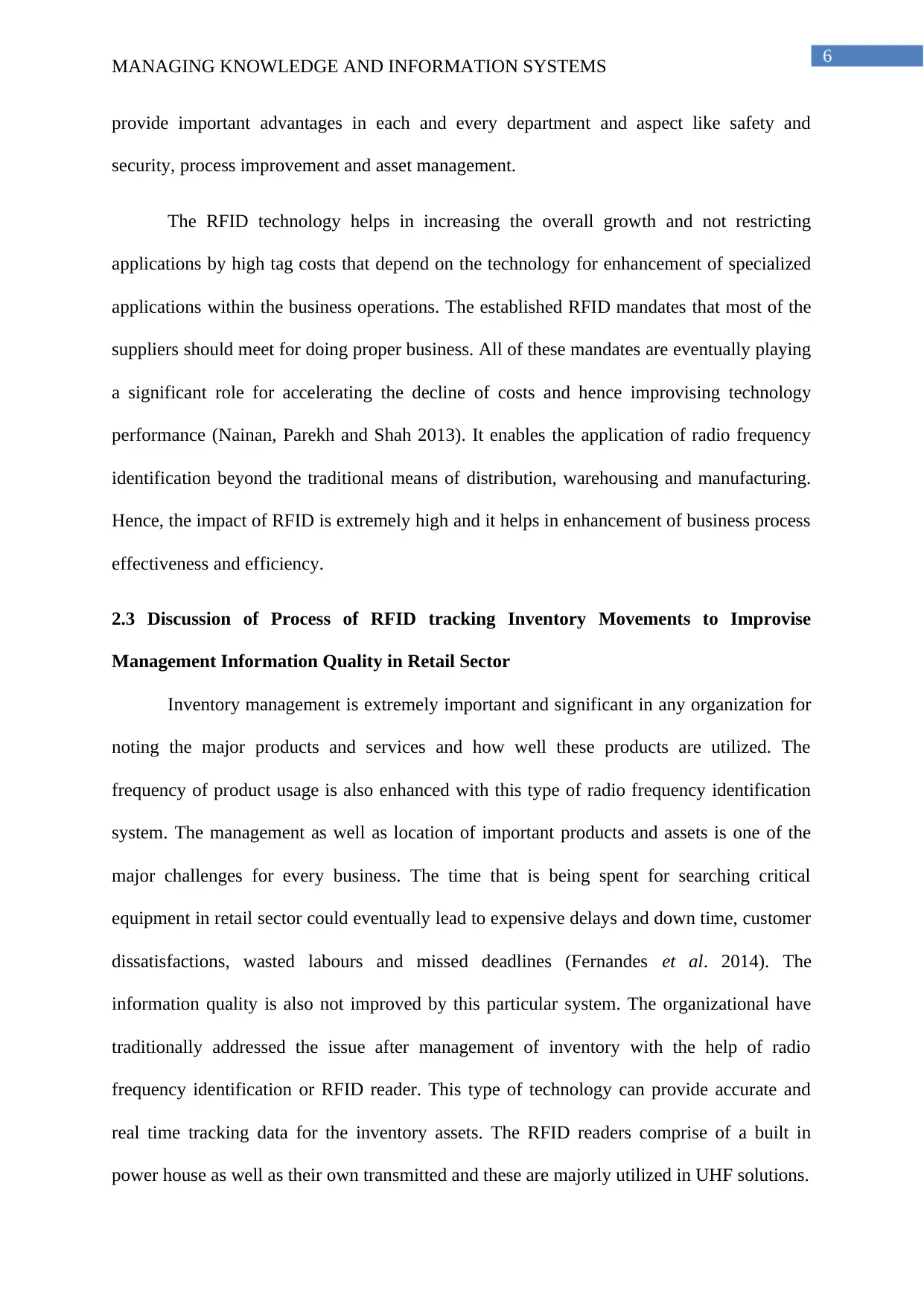
6
MANAGING KNOWLEDGE AND INFORMATION SYSTEMS
provide important advantages in each and every department and aspect like safety and
security, process improvement and asset management.
The RFID technology helps in increasing the overall growth and not restricting
applications by high tag costs that depend on the technology for enhancement of specialized
applications within the business operations. The established RFID mandates that most of the
suppliers should meet for doing proper business. All of these mandates are eventually playing
a significant role for accelerating the decline of costs and hence improvising technology
performance (Nainan, Parekh and Shah 2013). It enables the application of radio frequency
identification beyond the traditional means of distribution, warehousing and manufacturing.
Hence, the impact of RFID is extremely high and it helps in enhancement of business process
effectiveness and efficiency.
2.3 Discussion of Process of RFID tracking Inventory Movements to Improvise
Management Information Quality in Retail Sector
Inventory management is extremely important and significant in any organization for
noting the major products and services and how well these products are utilized. The
frequency of product usage is also enhanced with this type of radio frequency identification
system. The management as well as location of important products and assets is one of the
major challenges for every business. The time that is being spent for searching critical
equipment in retail sector could eventually lead to expensive delays and down time, customer
dissatisfactions, wasted labours and missed deadlines (Fernandes et al. 2014). The
information quality is also not improved by this particular system. The organizational have
traditionally addressed the issue after management of inventory with the help of radio
frequency identification or RFID reader. This type of technology can provide accurate and
real time tracking data for the inventory assets. The RFID readers comprise of a built in
power house as well as their own transmitted and these are majorly utilized in UHF solutions.
MANAGING KNOWLEDGE AND INFORMATION SYSTEMS
provide important advantages in each and every department and aspect like safety and
security, process improvement and asset management.
The RFID technology helps in increasing the overall growth and not restricting
applications by high tag costs that depend on the technology for enhancement of specialized
applications within the business operations. The established RFID mandates that most of the
suppliers should meet for doing proper business. All of these mandates are eventually playing
a significant role for accelerating the decline of costs and hence improvising technology
performance (Nainan, Parekh and Shah 2013). It enables the application of radio frequency
identification beyond the traditional means of distribution, warehousing and manufacturing.
Hence, the impact of RFID is extremely high and it helps in enhancement of business process
effectiveness and efficiency.
2.3 Discussion of Process of RFID tracking Inventory Movements to Improvise
Management Information Quality in Retail Sector
Inventory management is extremely important and significant in any organization for
noting the major products and services and how well these products are utilized. The
frequency of product usage is also enhanced with this type of radio frequency identification
system. The management as well as location of important products and assets is one of the
major challenges for every business. The time that is being spent for searching critical
equipment in retail sector could eventually lead to expensive delays and down time, customer
dissatisfactions, wasted labours and missed deadlines (Fernandes et al. 2014). The
information quality is also not improved by this particular system. The organizational have
traditionally addressed the issue after management of inventory with the help of radio
frequency identification or RFID reader. This type of technology can provide accurate and
real time tracking data for the inventory assets. The RFID readers comprise of a built in
power house as well as their own transmitted and these are majorly utilized in UHF solutions.
Paraphrase This Document
Need a fresh take? Get an instant paraphrase of this document with our AI Paraphraser
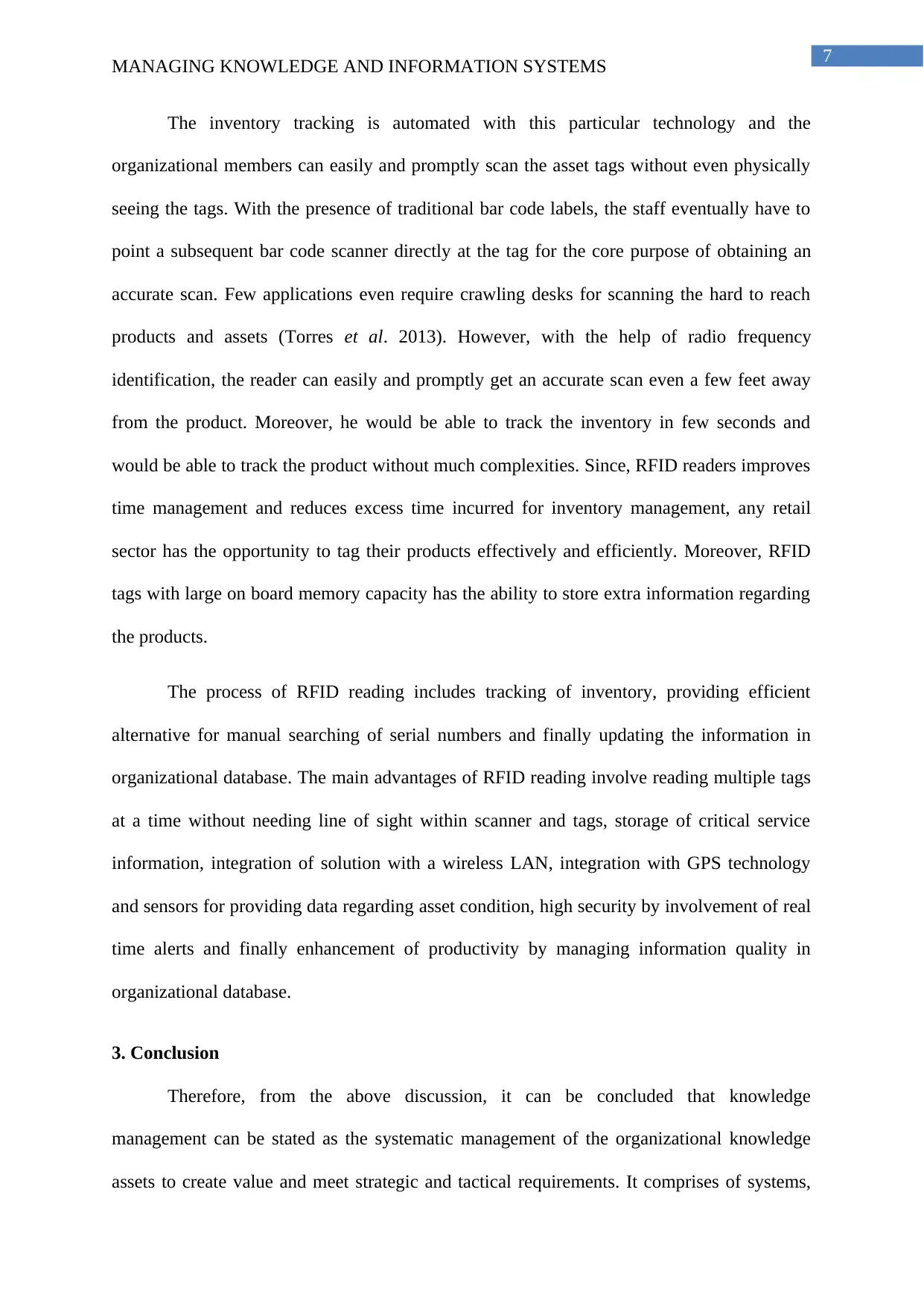
7
MANAGING KNOWLEDGE AND INFORMATION SYSTEMS
The inventory tracking is automated with this particular technology and the
organizational members can easily and promptly scan the asset tags without even physically
seeing the tags. With the presence of traditional bar code labels, the staff eventually have to
point a subsequent bar code scanner directly at the tag for the core purpose of obtaining an
accurate scan. Few applications even require crawling desks for scanning the hard to reach
products and assets (Torres et al. 2013). However, with the help of radio frequency
identification, the reader can easily and promptly get an accurate scan even a few feet away
from the product. Moreover, he would be able to track the inventory in few seconds and
would be able to track the product without much complexities. Since, RFID readers improves
time management and reduces excess time incurred for inventory management, any retail
sector has the opportunity to tag their products effectively and efficiently. Moreover, RFID
tags with large on board memory capacity has the ability to store extra information regarding
the products.
The process of RFID reading includes tracking of inventory, providing efficient
alternative for manual searching of serial numbers and finally updating the information in
organizational database. The main advantages of RFID reading involve reading multiple tags
at a time without needing line of sight within scanner and tags, storage of critical service
information, integration of solution with a wireless LAN, integration with GPS technology
and sensors for providing data regarding asset condition, high security by involvement of real
time alerts and finally enhancement of productivity by managing information quality in
organizational database.
3. Conclusion
Therefore, from the above discussion, it can be concluded that knowledge
management can be stated as the systematic management of the organizational knowledge
assets to create value and meet strategic and tactical requirements. It comprises of systems,
MANAGING KNOWLEDGE AND INFORMATION SYSTEMS
The inventory tracking is automated with this particular technology and the
organizational members can easily and promptly scan the asset tags without even physically
seeing the tags. With the presence of traditional bar code labels, the staff eventually have to
point a subsequent bar code scanner directly at the tag for the core purpose of obtaining an
accurate scan. Few applications even require crawling desks for scanning the hard to reach
products and assets (Torres et al. 2013). However, with the help of radio frequency
identification, the reader can easily and promptly get an accurate scan even a few feet away
from the product. Moreover, he would be able to track the inventory in few seconds and
would be able to track the product without much complexities. Since, RFID readers improves
time management and reduces excess time incurred for inventory management, any retail
sector has the opportunity to tag their products effectively and efficiently. Moreover, RFID
tags with large on board memory capacity has the ability to store extra information regarding
the products.
The process of RFID reading includes tracking of inventory, providing efficient
alternative for manual searching of serial numbers and finally updating the information in
organizational database. The main advantages of RFID reading involve reading multiple tags
at a time without needing line of sight within scanner and tags, storage of critical service
information, integration of solution with a wireless LAN, integration with GPS technology
and sensors for providing data regarding asset condition, high security by involvement of real
time alerts and finally enhancement of productivity by managing information quality in
organizational database.
3. Conclusion
Therefore, from the above discussion, it can be concluded that knowledge
management can be stated as the systematic management of the organizational knowledge
assets to create value and meet strategic and tactical requirements. It comprises of systems,

8
MANAGING KNOWLEDGE AND INFORMATION SYSTEMS
strategies, processes and initiatives, which sustain as well as enhance the creation,
refinement, sharing, assessment and storage of knowledge. The above provided report has
clearly demonstrated about management of knowledge and information systems with proper
impact of RFID and strategic importance of knowledge management.
MANAGING KNOWLEDGE AND INFORMATION SYSTEMS
strategies, processes and initiatives, which sustain as well as enhance the creation,
refinement, sharing, assessment and storage of knowledge. The above provided report has
clearly demonstrated about management of knowledge and information systems with proper
impact of RFID and strategic importance of knowledge management.
⊘ This is a preview!⊘
Do you want full access?
Subscribe today to unlock all pages.

Trusted by 1+ million students worldwide
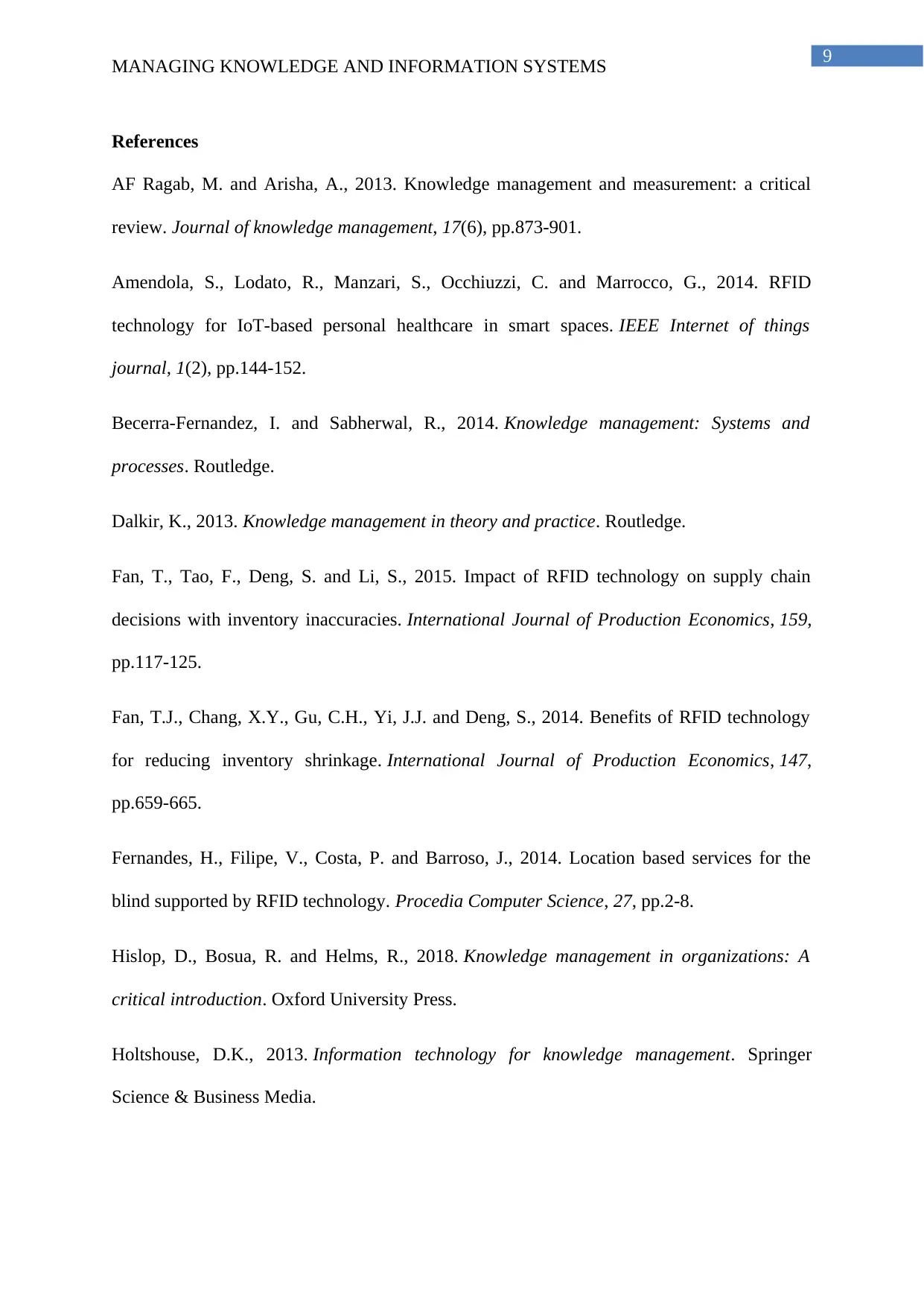
9
MANAGING KNOWLEDGE AND INFORMATION SYSTEMS
References
AF Ragab, M. and Arisha, A., 2013. Knowledge management and measurement: a critical
review. Journal of knowledge management, 17(6), pp.873-901.
Amendola, S., Lodato, R., Manzari, S., Occhiuzzi, C. and Marrocco, G., 2014. RFID
technology for IoT-based personal healthcare in smart spaces. IEEE Internet of things
journal, 1(2), pp.144-152.
Becerra-Fernandez, I. and Sabherwal, R., 2014. Knowledge management: Systems and
processes. Routledge.
Dalkir, K., 2013. Knowledge management in theory and practice. Routledge.
Fan, T., Tao, F., Deng, S. and Li, S., 2015. Impact of RFID technology on supply chain
decisions with inventory inaccuracies. International Journal of Production Economics, 159,
pp.117-125.
Fan, T.J., Chang, X.Y., Gu, C.H., Yi, J.J. and Deng, S., 2014. Benefits of RFID technology
for reducing inventory shrinkage. International Journal of Production Economics, 147,
pp.659-665.
Fernandes, H., Filipe, V., Costa, P. and Barroso, J., 2014. Location based services for the
blind supported by RFID technology. Procedia Computer Science, 27, pp.2-8.
Hislop, D., Bosua, R. and Helms, R., 2018. Knowledge management in organizations: A
critical introduction. Oxford University Press.
Holtshouse, D.K., 2013. Information technology for knowledge management. Springer
Science & Business Media.
MANAGING KNOWLEDGE AND INFORMATION SYSTEMS
References
AF Ragab, M. and Arisha, A., 2013. Knowledge management and measurement: a critical
review. Journal of knowledge management, 17(6), pp.873-901.
Amendola, S., Lodato, R., Manzari, S., Occhiuzzi, C. and Marrocco, G., 2014. RFID
technology for IoT-based personal healthcare in smart spaces. IEEE Internet of things
journal, 1(2), pp.144-152.
Becerra-Fernandez, I. and Sabherwal, R., 2014. Knowledge management: Systems and
processes. Routledge.
Dalkir, K., 2013. Knowledge management in theory and practice. Routledge.
Fan, T., Tao, F., Deng, S. and Li, S., 2015. Impact of RFID technology on supply chain
decisions with inventory inaccuracies. International Journal of Production Economics, 159,
pp.117-125.
Fan, T.J., Chang, X.Y., Gu, C.H., Yi, J.J. and Deng, S., 2014. Benefits of RFID technology
for reducing inventory shrinkage. International Journal of Production Economics, 147,
pp.659-665.
Fernandes, H., Filipe, V., Costa, P. and Barroso, J., 2014. Location based services for the
blind supported by RFID technology. Procedia Computer Science, 27, pp.2-8.
Hislop, D., Bosua, R. and Helms, R., 2018. Knowledge management in organizations: A
critical introduction. Oxford University Press.
Holtshouse, D.K., 2013. Information technology for knowledge management. Springer
Science & Business Media.
Paraphrase This Document
Need a fresh take? Get an instant paraphrase of this document with our AI Paraphraser
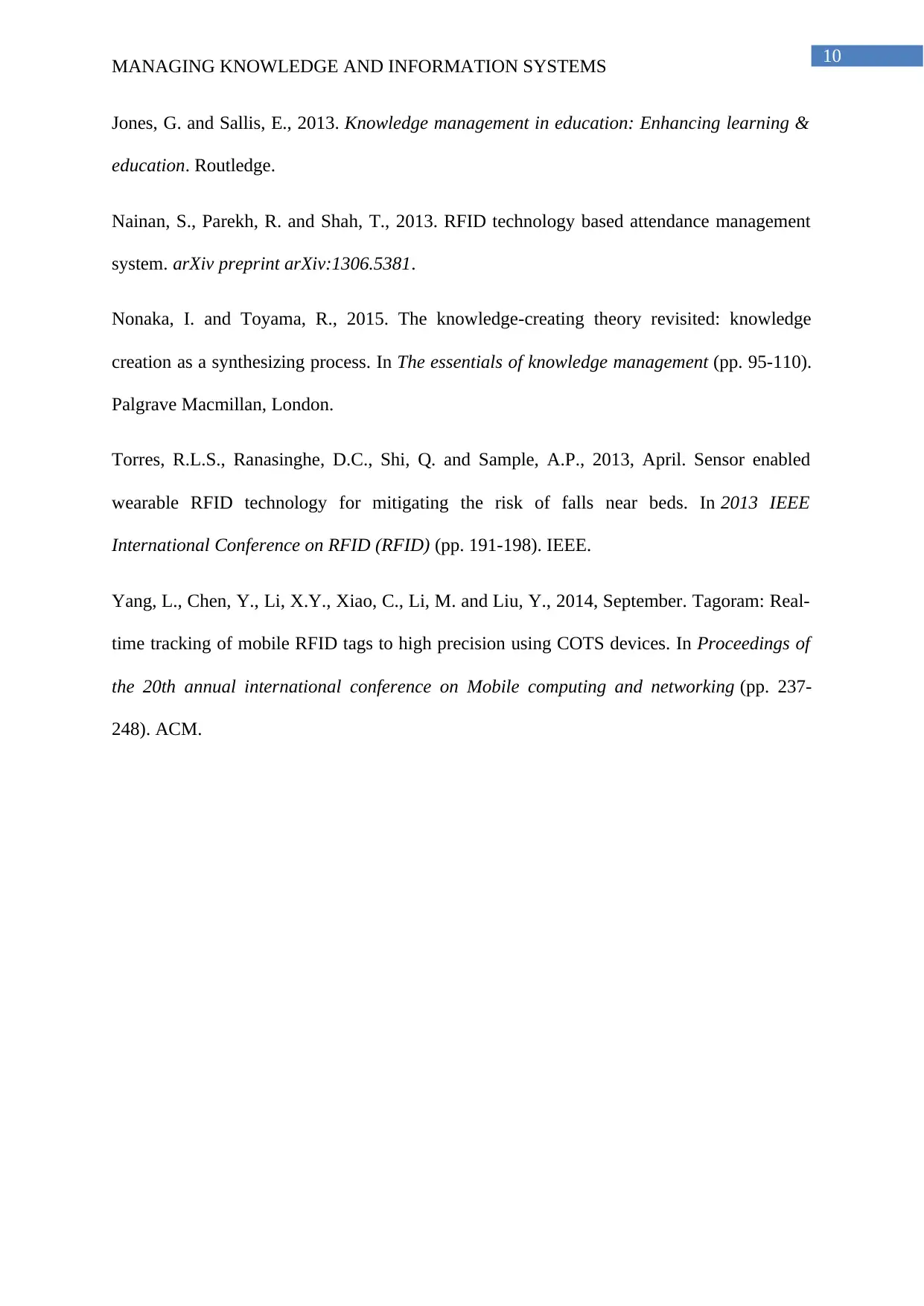
10
MANAGING KNOWLEDGE AND INFORMATION SYSTEMS
Jones, G. and Sallis, E., 2013. Knowledge management in education: Enhancing learning &
education. Routledge.
Nainan, S., Parekh, R. and Shah, T., 2013. RFID technology based attendance management
system. arXiv preprint arXiv:1306.5381.
Nonaka, I. and Toyama, R., 2015. The knowledge-creating theory revisited: knowledge
creation as a synthesizing process. In The essentials of knowledge management (pp. 95-110).
Palgrave Macmillan, London.
Torres, R.L.S., Ranasinghe, D.C., Shi, Q. and Sample, A.P., 2013, April. Sensor enabled
wearable RFID technology for mitigating the risk of falls near beds. In 2013 IEEE
International Conference on RFID (RFID) (pp. 191-198). IEEE.
Yang, L., Chen, Y., Li, X.Y., Xiao, C., Li, M. and Liu, Y., 2014, September. Tagoram: Real-
time tracking of mobile RFID tags to high precision using COTS devices. In Proceedings of
the 20th annual international conference on Mobile computing and networking (pp. 237-
248). ACM.
MANAGING KNOWLEDGE AND INFORMATION SYSTEMS
Jones, G. and Sallis, E., 2013. Knowledge management in education: Enhancing learning &
education. Routledge.
Nainan, S., Parekh, R. and Shah, T., 2013. RFID technology based attendance management
system. arXiv preprint arXiv:1306.5381.
Nonaka, I. and Toyama, R., 2015. The knowledge-creating theory revisited: knowledge
creation as a synthesizing process. In The essentials of knowledge management (pp. 95-110).
Palgrave Macmillan, London.
Torres, R.L.S., Ranasinghe, D.C., Shi, Q. and Sample, A.P., 2013, April. Sensor enabled
wearable RFID technology for mitigating the risk of falls near beds. In 2013 IEEE
International Conference on RFID (RFID) (pp. 191-198). IEEE.
Yang, L., Chen, Y., Li, X.Y., Xiao, C., Li, M. and Liu, Y., 2014, September. Tagoram: Real-
time tracking of mobile RFID tags to high precision using COTS devices. In Proceedings of
the 20th annual international conference on Mobile computing and networking (pp. 237-
248). ACM.
1 out of 11
Related Documents
Your All-in-One AI-Powered Toolkit for Academic Success.
+13062052269
info@desklib.com
Available 24*7 on WhatsApp / Email
![[object Object]](/_next/static/media/star-bottom.7253800d.svg)
Unlock your academic potential
Copyright © 2020–2025 A2Z Services. All Rights Reserved. Developed and managed by ZUCOL.





